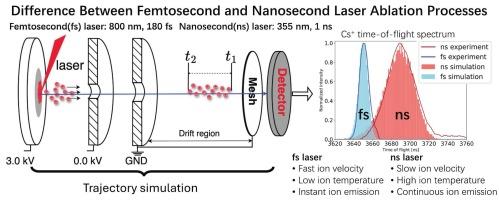飞秒和纳秒激光烧蚀过程的比较研究
IF 4.6
2区 物理与天体物理
Q2 MATERIALS SCIENCE, MULTIDISCIPLINARY
引用次数: 0
摘要
本文研究了受短脉冲激光相互作用的材料所发射离子的动力学特性。为了研究相同能量但不同时间尺度激光脉冲辐照对烧蚀动力学的影响,我们研制了飞行时间质谱仪,分析了180 fs 800 nm Ti:蓝宝石飞秒激光和1 ns 355 nm Nd:YAG纳秒激光辐照得到的TOF离子谱图。在400 ~ 1000 nJ的激光脉冲能量范围内,即飞秒激光器的激光强度为7.1 × 1011 ~ 1.8 × 1012 W/cm2,纳秒激光器的激光强度为1.3 ~ 3.2 × 108 W/cm2,研究了入射激光与CsI沉积物相互作用的影响。通过结合移动的麦克斯韦-玻尔兹曼初速度分布和连续离子发射的离子轨迹模拟,我们分析了来自TOF剖面的离子发射动力学。与纳秒激光器相比,飞秒激光器产生的离子具有更高的初始速度和更低的温度。在纳秒激光照射下,离子发射在激光脉冲结束后仍持续数十纳秒,且持续时间随激光脉冲能量的增加而增加。而在飞秒激光照射下,不发生连续发射。本文章由计算机程序翻译,如有差异,请以英文原文为准。

Comparative study of ablation processes using femtosecond and nanosecond lasers
This study investigated the dynamic characteristics of ions emitted from materials subjected to short-pulsed laser interactions. To investigate the difference in ablation dynamics due to laser pulse irradiation with the same energy but different time scales, we developed a time-of-flight (TOF) mass spectrometer and analyzed the TOF ion profiles obtained by irradiating 180 fs 800 nm Ti:sapphire femtosecond laser and 1 ns 355 nm Nd:YAG nanosecond laser. The effects of incident laser interaction with CsI deposits were examined for laser pulse energies ranging from 400 to 1000 nJ, corresponding to laser intensities of 7.1 × 1011–1.8 × 1012 W/cm2 for femtosecond lasers and 1.3–3.2 × 108 W/cm2 for nanosecond lasers. With an ion trajectory simulation incorporating a shifted Maxwell–Boltzmann initial velocity distribution and continuous ion emission, we analyzed the ion emission dynamics from the TOF profiles. Compared with nanosecond lasers, femtosecond lasers generated ions with higher initial velocities but lower temperatures. Under nanosecond laser irradiation, ion emission continued for tens of nanoseconds after the end of the laser pulse, and its duration increased with increasing laser pulse energy. However, no continuous emission occurred under femtosecond laser irradiation.
求助全文
通过发布文献求助,成功后即可免费获取论文全文。
去求助
来源期刊

Results in Physics
MATERIALS SCIENCE, MULTIDISCIPLINARYPHYSIC-PHYSICS, MULTIDISCIPLINARY
CiteScore
8.70
自引率
9.40%
发文量
754
审稿时长
50 days
期刊介绍:
Results in Physics is an open access journal offering authors the opportunity to publish in all fundamental and interdisciplinary areas of physics, materials science, and applied physics. Papers of a theoretical, computational, and experimental nature are all welcome. Results in Physics accepts papers that are scientifically sound, technically correct and provide valuable new knowledge to the physics community. Topics such as three-dimensional flow and magnetohydrodynamics are not within the scope of Results in Physics.
Results in Physics welcomes three types of papers:
1. Full research papers
2. Microarticles: very short papers, no longer than two pages. They may consist of a single, but well-described piece of information, such as:
- Data and/or a plot plus a description
- Description of a new method or instrumentation
- Negative results
- Concept or design study
3. Letters to the Editor: Letters discussing a recent article published in Results in Physics are welcome. These are objective, constructive, or educational critiques of papers published in Results in Physics. Accepted letters will be sent to the author of the original paper for a response. Each letter and response is published together. Letters should be received within 8 weeks of the article''s publication. They should not exceed 750 words of text and 10 references.
 求助内容:
求助内容: 应助结果提醒方式:
应助结果提醒方式:


